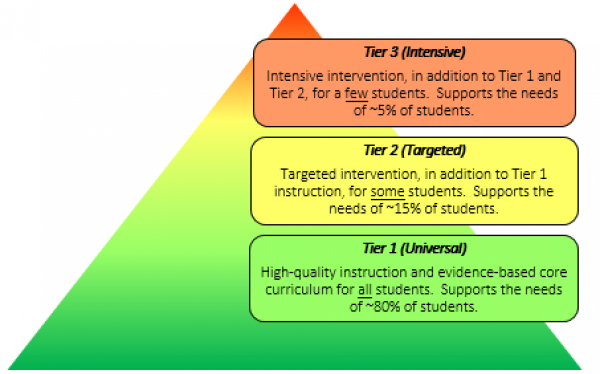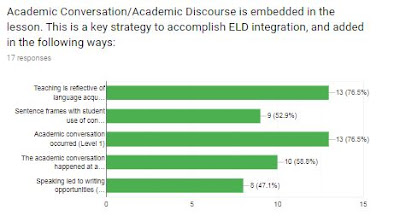NO EXCUSES UNIVERSITY – INTERVENTIONS
Culture of Universal Achievement
Collaboration
Standards Alignment
Assessment Plan
Data Analysis
Interventions
“Once children are taught what they need to learn and then assessed for their levels of proficiency, there needs to be appropriate, data-driven academic interventions to help students who are not on track to be proficient by the end of the year. There also needs to be similar social interventions, because children who are emotionally well adjusted are much more likely to be academically successful.”
During our Academic Conferences we discussed interventions for our students. In reviewing the data, we have moved past the excuses and how we can help them at school :)
When we review data, we focus on what the students don’t know and how we are going to provide interventions to support the students learning.
We have now completed MAP assessments. What are you doing with the data? What interventions have you put in place? Here is an example:
If your student scores have low RIT score. You are able to drill down into the results to determine on which standards the students need support in. As an example in Math, when one drills down further into the data, you may notice that the majority of the students struggled with expressions and equations. A smaller number also struggled with use functions to model relationships. Then the teacher is able to develop very targeted lessons that can be delivered in a small group setting. The teacher does not have to re-teach the entire class. Targeted, immediate intervention will have a positive impact on student achievement.
We have just finished giving our district writing prompt.
11 Storyboarding Apps To Organize & Inspire Young Writers
iPadifying the Writing Workshop
Some ideas for conferences and report cards:
During conferences you can sit side by side with your laptop and have a student chromebook. Have parents sign into parent portal on the chromebook. Please watch the video below so you can check to see which parents have not signed up. You can then have a print out of codes if you need it and then have parents sign into parent portal. You can have separate signature sheet that parents can sign so that way you know who attended conferences.
Click on link for video below....
Question came up how can I tell if parents have looked at progress reports- you can sign into your account and you can see which parents have signed in.
Question came up how can I tell if parents have looked at progress reports- you can sign into your account and you can see which parents have signed in.
Curriculum, Instruction, and Assessment Updates
Now that we have completed our Fall MAP test administration, what
do we do with the results? Come learn how to run essential reports,
snorkel through your data, and scuba dive deep into
the Learning Continuum. You’ll learn how to create your small groups
and inform your instruction.
do we do with the results? Come learn how to run essential reports,
snorkel through your data, and scuba dive deep into
the Learning Continuum. You’ll learn how to create your small groups
and inform your instruction.
MAP Essential Reports PD dates:
October 29
October 30
Central Office, PLC 2 4pm-5:30pm
Tips for Teachers:
Top 4 Reports That Every Teacher Should Run After Administering MAP:
- Class
- Class Breakdown
- Achievement Status and Growth Projection Summary
- Student Profile
The normative data chart on the posters we have in our classrooms, represents students in
the 50th percentile in the U.S. In order to meet the standards (Level 3) on the CAASPP, students
must score in approx. the 60th percentile. In FSUSD to increase a student’s percentile level,
multiply each child’s projected RIT growth points by 1.5 to calculate a stretch goal. You will
find this data on the “Achievement Status and Growth Projection or Summary Report” at nwea.org.
the 50th percentile in the U.S. In order to meet the standards (Level 3) on the CAASPP, students
must score in approx. the 60th percentile. In FSUSD to increase a student’s percentile level,
multiply each child’s projected RIT growth points by 1.5 to calculate a stretch goal. You will
find this data on the “Achievement Status and Growth Projection or Summary Report” at nwea.org.
(Additional posters are available by request)
Halloween day costumes: follow school dress code, no weapons, no blood, no masks, no blow up costumes. Make sure food brought in on October 31 follows food policy guidelines.
Observable Fish Moments at SV:
Be There: Thank you for making our district site visit a success!!
Play: Thank you for attending our Harvest Festival. I know students love to see their teachers at our school events.
Choose your attitude: Your attitude can decide how you will feel for the rest of the day- EVERY DAY!! Especially during power outages :)
Make Their Day: Make at least one positive phone home this week.

/cdn.vox-cdn.com/uploads/chorus_image/image/65143874/AI_fiction_writing_GettyImages_1124658526.0.jpg)













